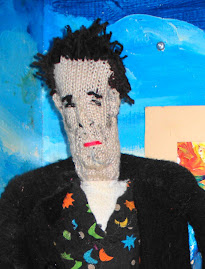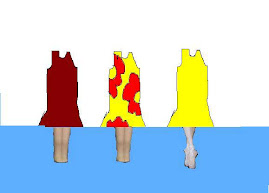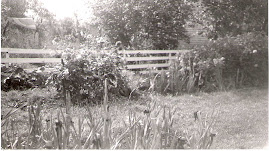FATE, DESTINY AND
SELF DETERMINATION
LE SORT, LE
DESTIN ET L'AUTO-DETERMINATION
EXHIBITION
September 18-October 5 2014.
Craft Ontario
990 Queen Street
West
Toronto Ontario
Opening reception: Thursday September 18 2014 6-9pm.
With a plethora of shapes and a
multiplicity of colour and textures, Fate, Destiny and Self Determination
spreads itself across the wall of Craft Ontario’s gallery space in a riotous
constellation. Aesthetically exciting and intellectually inviting, this project
is a celebration of tapestry weaving and its history, interpreted through the
hands of many, using many techniques. Felted, knitted, crocheted, woven and
mixed-media pieces from fibre enthusiasts from more the 22 countries are
featured in this community creation, conceived of and executed by Canadian
tapestry artist, weaver and educator Line Dufour.
Although Fate, Destiny And Self
Determination as a title speaks to many things in life, in this case, the
focus is on tapestry as medium of expression, and its history and development
as a decorative technique. Despite the
philosophical interpretation of the title, pessimism or optimism, the
individual’s ability to exist with in a master plan, that regardless of
individual self has already accommodated your difference, not unlike a
“factory” produced tapestry built on an artist cartoon, there is an over all
cohesion of structure provided by the technique itself. The technique of
tapestry is to use the weft threads (compacted to hide the warp threads) to
create an image on the surface/ front of a piece of cloth. You are born, you breathe,
time passes and you die, what philosophy you chose the end result is the same.
Some may find that a pessimistic outlook that disallows the individual’s choice
to have any influence on the outcome, the “deity” / designer / structure
holding the whole in place unalterable, others may have an optimistic security
in knowing/ believing there is a structure that will bare the weight of their
existence. Either way there is a beginning (anchor 1), a middle and an end
(anchor 2) and in the case of the “Fate, Destiny And Self Determination:
Tapestry Project, I can quote Gertrude Stein and say “but not necessarily in
that order.”
Line Dufour, from her base of operations
the Toronto Weavers School, brought this project about through what I see as
five separate components: the cartoon, the segmenting and distribution of those
segments, the bringing together of these dispersed elements, and the mounting /
design of the exhibition itself. The fifth component, or possibly the first, is
the entire process being documented in a journal of sorts, which exists online
in numerous postings on Tapestry Blog. You can see the individual shapes along
with the creation of the two anchors.
The creation of these anchors speaks of a
period of European tapestry production dating back to the Middle Ages, when
tapestry manufacturing produced large scale pictorial wall hangings rather than
small decorative works, rugs, or elements on garments. With many individuals
working side by side across the warp, making a single Tapestry hanging, the
uniformity of the whole piece was the goal along with a low price point in a
growing and competitive market place. Individual skill and creative imagination
were not the point, speed and accuracy were.
These types of “wall hangings” inform our collective knowledge of what a
tapestry is, but have shifted from the position of dominance they held over
painting as an art form, which prior to and
through the renaissance was a decorative face to a wall or furnishing,
not a portable flat canvas or board that we associate with painting. While a
portable painting from this period may be thought of as a finished product
today, then it was only the sketch from which a scaled up cartoon was made in order
to create the tapestry which was the end result of choice, since hanging a textile based upon a painted image
had been a less expensive way to decorate if you could not afford a fresco.
Frescoes came along, (replacing hung textiles which provided a form of much
needed insulation as well as décor), as a marker of permanence and power, but
lost ground to tapestry as a marker of wealth along with power. The imagery was
predominately narrative, whether mythical, religious or depicting actual events
such as specific battles, and spoke to the shoppers/ clients/ patron’s ego, not
the makers, and as in earlier frescos and latter painting, the client’s
likeness was often incorporated into a dominant figure in the tapestry. This
type of many-handed “manufacturing” had been ongoing since the renaissance,
with the same “commemorative” function, however, by the mid-Victorian era, the
gain of a secondary market of collectors, along with commissioning patrons,
allowed for the shift of tapestry into the merely “decorative” market rather
than its previous dominance of the pre-fine art European marketplace.
The individual submitted shapes mark the
post world war two Studio Craft movement which for tapestry weavers began
earlier in the 20th century when a combination of trends in modern
architecture, construction materials and the newly invented job of interior
designer made renaissance tapestry blasé (not to mention too large for smaller domestic space the rich
came to inhabit). While the tapestry
factories, which had become fewer, continued to shut down, the encouragement
for individual experimentation and weavers to work independently with their own
designs came to dominance in design schools in Europe, most notably, the
Bauhaus. At this time, architects of featureless cement and steel buildings
(the form over function world) called for tapestry to add warmth/ colour and
deaden sound in their creations, whether large scale corporate lobbies or stark
individual homes or apartments. Tapestry
weavers moved out of the factory and into their own studios, and after WW2
entered the Art versus Craft world, which was a location they had not
previously inhabited, being that Tapestry had been located in its own territory
for nearly five centuries as handmade decorative objects and as status symbols.
Tapestries were one of the few fibre based products that had not been changed
or mechanized by the industrial revolution, yet they proved to be inspiration
for the assembly line.
In Fate,
Destiny and Self Determination, the right and left sides of the cartoon,
which are the full height of the cartoon, were worked on as complete pieces, by
many individuals who were students of the Toronto Weavers School, along
with invited guests and people who just dropped in. I, myself, dropped in twice: once by myself,
and once to bring California based fibre artist Valentyna Royenko Simpson, whom
I had met at the European Textile Network’s 2011 symposium in Kaunas Lithuania
during the Kaunas Textile Biennial, who was visiting Toronto and I was showing
her around. The rest of the “shapes”
were sent to individual textile artist, weavers, knitters, felt makers etc.
from across the planet, which were invited or responded to a call to
participate.
While choosing to remain independent of the
industrial world, the current users of this technique dedicate their individual
imagination and creative energy to making unique and individual objects. The restriction of shape (but not size) for
this project has produced results ranging from definitive expression of their
practice and/or bold leaps in experimentation from the tapestry weaving to very
interesting creations in other fibre based manipulations.
With the installation of this concept and
its components across the gallery wall Line Dufour present a first sighting of
a work in progress. Seeing this seductive community tapestry live has been a
breath taking experience. Craft Ontario needs to be thanked for choosing to
allow this project to come to life on their wall, To Line Dufour for proceeding
from concept onward and to all those who participated to make this object into
the event it became.
The installation of this concept and its
components streak across the gallery wall creating a universe of colour and
texture it succeeds
Links related to this story
Line Dufour: Tapestry Line Unlimited
Tapestry Line Blog http://tapestryline.blogspot.ca/
Toronto Weaving School at www.torontoweavingschool.com
Craft Ontario http://www.craftontario.com/
Canadian Tapestry Network http://www.canadiantapestrynetwork.com/
American Tapestry Alliance http://americantapestryalliance.org/












No comments:
Post a Comment